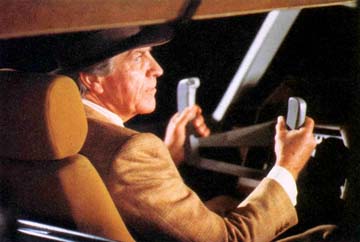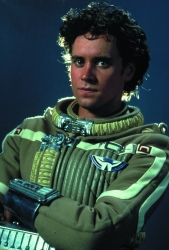|
The Last Starfighter (1984) was a groundbreaking science fiction film for its time, but one overlooked by the movie going public of the day. The film was farsighted in its demonstration of both the advantages and the drawbacks of CGI technology.
TLS was the first movie to entirely replace the customary special effects miniatures -- the industry standard for decades -- with all digital special effects.
Digital Productions was the trailblazing firm that saw the future and proved what could be done, basically inventing a new set of standards and procedures still used today. Unlike many of the effects extravaganzas of today's summer blockbusters, the effects are not the be-all and end-all of the film and don't overpower the story.
Alex Rogan (Lance Guest) lives at the Starlite Starbrite trailer park located amidst a beautiful but remote mountain setting. Alex is a young man who helps Otis (Vernon Washington) with handyman chores in the close, family oriented community. When not engaged with chores, he's out with his friends or girlfriend, Maggie (Catherine Mary Stewart) or playing "Starfighter", an arcade game in which the player defends the universe against the evil Xur and Kodan Armada.
Alex is dissatisfied with his life and the limited options open to him, trapped by the obligations to his mother and Maggie, who cares for her grandmother. He has his eye on bigger goals, like getting that college loan and moving away.
After an amazing session of "Starfighter", cheered on by virtually the entire trailer park, Alex beats the machine and sets a new record. But his euphoria is dashed when he learns that his college loan is denied.
| It is his darkest hour, the depths of which are broken by the insistent talking and shaking of the Starfighter game. At the same time, a fantastic DeLorean-style car arrives. It is Centauri (Robert Preston), the game's inventor, searching for the new record breaker.
Centauri coaxes Alex into the car, then speeds away (at 303 mph). The car, actually a spacecraft, lifts off, hurtling Alex and Centauri, who is an alien in a mask, to the planet Rylos. The events of the game are actually based on real-life events. |

Robert Preston as Centauri |
Just as in the game, Alex has been recruited by the Star League to fight against Xur and the Kodan Aramada.
But Alex declines, fearful of his ability to perform and worried of the inherent dangers. As he is returned to Earth, Rylos is hit by Xur and all the Starfighters are killed.
Back at home, Alex discovers that a Beta-Unit Simuloid -- a perfect replica of himself --has replaced him to cover his absence. When it is learned that Alex escaped alive, a Zandozan, an interstellar hit beast is sent to kill him. But Centauri returns and helps defeat the beast, giving Alex the bad news -- as long as he lives he, his family and loved ones will be under threat of death. And if assassins don't get him first, inevitably, Xur will reach Earth in his maniacal quest to rule the cosmos. Alex decides to fight and returns to Rylos, discovering to his dismay that he is now the last Starfighter, the fate of the entire universe in his hands.
Together with his pilot, Grig (Dan O'Herlihy), Alex demonstrates that the Force is with him. With the enemy vanquished, Alex is invited to help rebuild the Star League and forever keep the universe safe.

Lance Guest as Alex |
TLS is a sort of coming of age story in which Alex must grapple with his inner fears and insecurities to discover who he really is and to grab the gold ring of opportunity before it passes him by. Lance Guest, vaguely reminiscent of Jeff East (Superman) projects the correct doubt and inner resolve necessary to make Alex a believable character. Like Mark Hamill, whose Luke Skywalker character bears certain similarities, this film and role didn't do much for Guest's career. Although he has worked through the years, mostly in TV, he's never had another breakout role with the potential of this one.
Similarly, Catherine Mary Stewart was unable to parlay her role as Maggie (Megs) into higher profile assignments. She has a solid screen presence and is unassumingly attractive, a real chestnut-haired girl next door. |
The two roles that really "make" this film, though, are those of Centauri and Grig. Grig is a Star League pilot, reptilian in appearance, in fact, described as an iguana. Dan O'Herlihy, under heavy make-up, gives Grig a gung-ho, never-say-die attitude bolstered by the good spirits engendered from his frequent, wheezy laugh. As played by Robert Preston, he of The Music Man fame, Centauri takes on the persona of an outer space huckster, a fast-talking alien Harold Hill, cheerful and unflagging in his search for Starfighter recruits. The enormous charisma of these two veterans fills the film with energy whenever they are on screen. (Incidentally, this was Preston's last theatrical film, but not his last film role. He made two more made-for-TV films after this one. And while I'm at it, although Wil Wheaton, of Star Trek: The Next Generation, is listed, his role was cut from the movie.)
Jonathan Betuel's screenplay is what we would call "sweet," even in that age of E.T., everyone upbeat and optimistic, the only profanity uttered by the cute kid brother, the happy ending never out of sight and all in service of a feel-good popcorn movie entertainment. His success at this, aided greatly by Nick Castle's compassionate direction, makes his lack of career momentum perplexing. Betuel likens his story to that of The Sword and the Stone with his version substituting the video game for the sword Excalibur. Betuel's only outright error is his failure to provide any resolution regarding Xur's fate. The villain simply jumps into an escape pod and disappears from the movie. Was Betuel leaving the door open for a sequel?
The special effects serve the story and hold up well enough on video. Given that this film about a video game that becomes reality it is perhaps forgivable that some of the effects only achieve the level of really good game graphics. But no one had done them on this scale before and considering the budget and time limitations imposed on the production it is remarkable what they were able to achieve. There might be another area in which this film was a groundbreaker: The end credits announce the availability of the Atari home video game version of The Last Starfighter.
Craig Safan's music hits the right moods, although the military/heroic themes sound a bit like the music from Ira Newborn?s Naked Gun scores.
This Universal DVD also contains a nice documentary, Crossing the Frontier: Making The Last Starfighter. Guest hosts, with many of the film?s key creative personnel -- Castle, Betuel, John H. Whitney Jr. (associate producer and the man behind Digital Productions), Safan, Ron Cobb (Production Designer), etc. -- detailing the film?s production history. It is particularly good at communicating the excitement of being explorers in the digital realm and making all these pioneering discoveries. Castle makes a very prescient statement when he remarks that "I think you see a certain amount of the charm and schmaltz of a Hollywood musical in there? um, without the music." Little could he know that his film would actually become a stage musical in 2004 (with a cast album released by Kritzerland in 2005).
|






